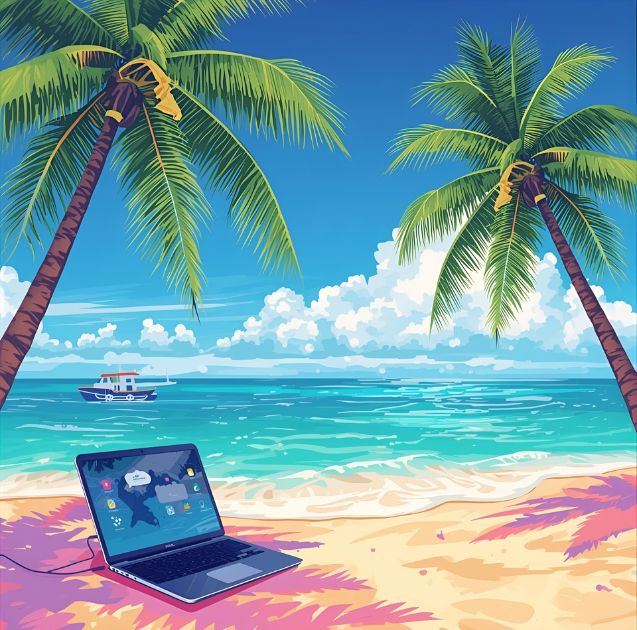
The Dawn of a New Era: Redefining Work and Travel

The traditional nine-to-five has been reimagined. The line between a vacation and a workday is blurring, giving rise to a new class of professional: the digital nomad. It’s a dream for many—swapping a cubicle for a beachfront café, a stuffy commute for a morning stroll through a historic European city. But this dream of ultimate freedom is built on a foundation of meticulous planning and preparation. The idea can be so overwhelming that many aspiring nomads get stuck in the planning phase, never taking the leap.
That’s where this blueprint comes in. We’ve distilled the complex process into ten essential pillars. This isn’t just a packing list; it’s a holistic guide to building a sustainable and fulfilling life on the road. Whether you’re a freelance developer, a content creator, or a remote employee, mastering these ten areas will transform your dream of location independence into a tangible reality. Let’s build your foundation for a life of work and wonder.
Pillar 1: The Technological Tether – Your Digital Lifeline
Your technology is your office, your connection to clients, and your entertainment hub. It’s non-negotiable. Don’t skimp here.
The Holy Trinity: Laptop, Phone, and Power
Your laptop is the heart of your operation. Prioritize a balance of power, portability, and battery life. An ultrabook like a MacBook Air or a Dell XPS is often the perfect choice. Before you leave, ensure it’s in peak condition. Clean up the hard drive, update all software, and back everything up to a cloud service and a physical hard drive.
Your smartphone is your navigator, translator, and secondary work device. Ensure it’s unlocked so you can use local SIM cards, which are almost always cheaper than international roaming plans. Download essential apps like Google Maps (with offline areas), Google Translate, a currency converter, and your banking apps before you depart.
Finally, power is paramount. A high-capacity portable power bank is a lifesaver during long travel days or in places with unreliable electricity. Invest in a high-quality universal travel adapter with multiple USB ports and surge protection. Nothing is worse than a power surge in a foreign country, frying your expensive equipment.
Pillar 2: The Connectivity Conundrum – Staying Online, Everywhere
No internet, no work. It’s that simple. Your connectivity strategy needs to be robust and multi-layered.
- Local SIM Cards: As mentioned, this is your primary tool. Upon arriving in a new country, make getting a local SIM with a generous data plan one of your first tasks. Research providers beforehand on sites like Prepaid Data SIM Card Wiki.
- eSIM Technology: If your phone supports it, services like Airalo or Holafly allow you to purchase and activate data plans for various countries digitally, often before you even land. It’s incredibly convenient.
- Portable Wi-Fi Hotspot: For those who need an ultra-reliable connection for multiple devices, a portable Wi-Fi hotspot (like a Solis or GlocalMe) can be a worthwhile investment. It provides a secure network wherever you have a cell signal.
- VPN (Virtual Private Network): This is a non-negotiable for security and accessibility. A VPN encrypts your internet traffic, protecting you on public Wi-Fi networks (cafes, airports). It also allows you to access websites and services that might be geo-blocked in your current location.
Pillar 3: The Bureaucratic Maze – Visas and Legalities
This is the least glamorous but most critical pillar. Ignoring it can end your trip before it truly begins. Never assume you can just work on a tourist visa. While many nomads do, it exists in a legal grey area and can carry risks.
Research visa requirements for your nationality in every country you plan to visit. Many countries now offer specific “digital nomad visas” that provide a legal framework for you to live and work remotely for an extended period. Websites of embassies and consulates are your primary source of truth. Keep track of entry requirements, duration of stay, and any income or insurance prerequisites. Always have digital and physical copies of your passport, visas, birth certificate, and other important documents.
Pillar 4: The Financial Fortress – Managing Money Across Borders
Managing finances from abroad requires a modern banking setup.
Banking Without Borders
Your home bank might hit you with exorbitant foreign transaction fees and ATM withdrawal fees. Mitigate this by opening accounts with banks known for their international-friendly features. Look for:
- Zero Foreign Transaction Fees: Essential for both debit and credit cards.
- ATM Fee Reimbursement: Banks like Charles Schwab (in the US) or neobanks like Revolut and Wise are popular choices for nomads.
- A Good Travel Credit Card: Beyond no fees, a good travel credit card can offer points, travel insurance, and other perks.
Always carry at least two different cards and a small amount of emergency cash. Inform your banks of your travel plans to avoid your cards being frozen for suspicious activity. Use an app like Trail Wallet or a spreadsheet to track your expenses in different currencies.
Pillar 5: The Safety Net – Comprehensive Insurance
Your standard travel insurance may not be enough. Most are designed for short holidays and often have exclusions if you are working or staying in a country for an extended period. Furthermore, they typically don’t cover healthcare in your home country.
Enter digital nomad health insurance. Companies like SafetyWing and World Nomads have created plans specifically for this lifestyle. These plans offer a flexible subscription model and provide global medical coverage. Read the policy details carefully to understand what’s covered, including medical emergencies, theft of electronics, and trip cancellations. This is your ultimate safety net; don’t leave home without it.
Pillar 6: The Art of Packing – Less is More
Every item you pack is an item you have to carry. The goal is to be prepared, not to carry your entire house on your back.
The One-Bag Philosophy
Many experienced nomads swear by the “one-bag” method, fitting everything into a single carry-on-sized backpack. This saves you checked bag fees, reduces the risk of lost luggage, and makes you more mobile.
Invest in a high-quality travel backpack (40L is often the sweet spot). Look for one that opens clamshell-style like a suitcase for easy access. Use packing cubes to compartmentalize your clothes and electronics. Your wardrobe should be a small collection of high-quality, versatile, and layerable pieces made from fabrics like merino wool, which is odor-resistant and temperature-regulating.
Pillar 7: The Workspace Quest – Finding Your Productivity Zone
While working from a hammock sounds idyllic, it’s rarely practical. You need a dedicated space to be productive.
Your accommodation choice is key. When booking an Airbnb or hotel, scrutinize the photos for a proper desk and chair. Wi-Fi speed is a crucial amenity; don’t hesitate to message the host and ask for a speed test screenshot. Beyond your accommodation, explore local co-working spaces. They offer reliable internet, an ergonomic setup, and, most importantly, a community of like-minded individuals.
Pillar 8: The Health and Wellness Protocol – Staying Fit on the Road
It’s easy to let your health routines slide while traveling. Prioritizing your physical well-being is crucial for long-term sustainability.
Create a portable fitness routine. Resistance bands are lightweight and versatile. Many bodyweight fitness apps require no equipment at all. Make a conscious effort to walk and explore your new environment. When it comes to food, enjoy the local cuisine, but also find a local market and cook some of your own meals to maintain a balanced diet. Stay hydrated, prioritize sleep, and pack a small, personalized first-aid kit with any prescription medications you need.
Pillar 9: The Social Connection – Building a Community
Loneliness is one of the biggest challenges for digital nomads. Proactively building a community is essential for your mental health.
Use platforms like Meetup.com or Facebook groups for expats and digital nomads in your city. Join a co-working space, take a local language class, or sign up for a group activity like a cooking class or a hiking club. Don’t just be a tourist; be a temporary resident. Engage with locals, learn a few phrases in their language, and be open to new connections. These relationships will enrich your travel experience far more than any landmark.
Pillar 10: The Mindset Shift – Embracing Flexibility and Resilience
This final pillar is the glue that holds everything together. The digital nomad life is not a permanent vacation. It’s real life, just in a different location, and it comes with its own unique challenges.
Flights will be delayed, Wi-Fi will fail during an important call, and you will experience culture shock. The key is to cultivate a mindset of resilience and adaptability. Learn to be comfortable with uncertainty. See challenges not as roadblocks but as part of the adventure. Stay organized with your work, but allow for spontaneity in your travels. This balance is the true art of the digital nomad lifestyle.
Your Blueprint to Freedom
Becoming a digital nomad is a journey, not a destination. By building a strong foundation across these ten pillars—from your tech and finances to your health and community—you are not just planning a trip. You are designing a life. A life of freedom, flexibility, and profound global experience. The world is waiting. It’s time to start building.
If you’re an introvert dreaming of solo travel but feeling a bit hesitant, The Introvert & Blueprint: How to Conquer Your First Solo Trip in 2025 offers gentle guidance and practical tips to help you step out comfortably and confidently.




Leave a Reply